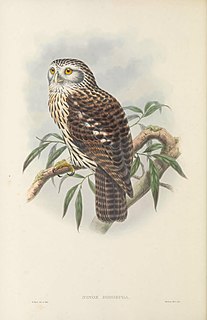 W
WThe Solomons boobook, also known as the Solomons hawk-owl, is a small to medium-sized hawk owl, measuring 23–31 cm (9.1–12.2 in) in length. Its upperparts are rusty brown, sometimes spotted or barred with white, its chest is buffy white, sometimes spotted or barred with brown, and its creamy belly is unmarked. It has a grayish-brown facial disc, edged by narrow white eyebrows and a band of white across the throat.
 W
WThe Australian boobook is a species of owl native to mainland Australia, southern New Guinea, the island of Timor, and the Sunda Islands. Described by John Latham in 1801, it was generally considered to be the same species as the morepork of New Zealand until 1999. Its name is derived from its two-tone boo-book call. Eight subspecies of the Australian boobook are recognized, with three further subspecies being reclassified as separate species in 2019 due to their distinctive calls and genetics.
 W
WThe greater sooty owl is a medium to large owl found in south-eastern Australia, Montane rainforests of New Guinea and have been seen on Flinders Island in the Bass Strait. They have a finely white spotted head with scattered white spots on the wings. The females are lighter colored than the males. The females' length is 37–43 cm and weighs 750-1200 g. The smaller male has a length of 37–43 cm and weighs 500-700 g. The wing length is 30–40 cm. The large dark eyes are set in a round large facial disk. The facial disk is dark gray-silver or sooty black and has a heavy black edge. The upper part of the owl is black to dark gray and the under part is lighter. The tail is short and the legs are feathered. The feet and talons are large. Their call is a piercing shriek which can last up to two seconds.
 W
WThe lesser sooty owl is an owl that lives in the wet tropics region of Australia. It is sometimes considered conspecific with the greater sooty owl, Tyto tenebricosa, by some authors. The birds are then together commonly referred to as sooty owl. Like other birds of prey, the female is bigger than the male. The lesser sooty owl is part of the masked group of owls: an important part of the environment because they are efficient predators that keep down rodent populations.
 W
WThe morepork, also called the ruru or Tasmanian spotted owl, is a small brown owl found throughout New Zealand and Tasmania. Described by Johann Friedrich Gmelin in 1788, it was for many years considered to be the same species as the Australian boobook of mainland Australia until 1999. Its name is derived from its two-tone call. Four subspecies of the morepork are recognized, one of which is extinct and another that exists only as a hybrid population. The bird has almost 20 alternative common names, including mopoke and boobook—many of these names are onomatopoeic, as they emulate the bird's distinctive two-pitched call.
 W
WThe Papuan hawk-owl is a medium-sized, sleek owl with a proportionately small head, long tail, and short, rounded wings. Its white facial disk is small and indistinct, with black streaks, and white eyebrows. It has buff-colored upperparts and barred black and brown underparts. Its eyes are bright yellow, and it has a gray to black bill. The male is larger than the female, which is unusual among owls.
 W
WThe powerful owl is a species of owl native to south-eastern and eastern Australia, the largest owl on the continent. It is found in coastal areas and in the Great Dividing Range rarely more than 200 km (120 mi) inland. The International Union for Conservation of Nature (IUCN) Red List of Threatened Species also refers to this species as the powerful boobook. An apex predator in its narrow distribution, the powerful owl is often an opportunist like most predators, but generally is dedicated to hunting arboreal mammals, in particular small to medium-sized marsupials. Such prey can comprise about three-quarters of their diet. Generally, this species lives in primary forests with tall, native trees, but can show some habitat flexibility when not nesting. The powerful owl is a typically territorial raptorial bird that maintains a large home range and has long intervals between egg-laying and hatching of clutches. Also, like many types of raptorial bird, they must survive a long stretch to independence in young owls post-fledging. Unlike most raptorial birds, however, male powerful owls are larger and stronger than females and so the male takes the dominant position in the mating pair, which extends to food distribution.